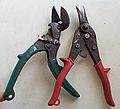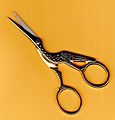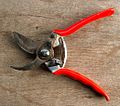scissors
A pair of scissors is a tool for non-cutting cutting or cutting into different materials - mostly by means of two mutually movable blades with cutting edges , also called scissor levers or branches .
The cutting process is carried out by pushing the material between the blades at the point to be cut and then allowing them to slide past each other. There are different shapes and types of scissors, depending on the material and purpose they are intended for.
Word origin
The noun “scissors” comes from the Old High German form scāri from the Indo-European root * (s) ker- “cut”, to which the words sharp , scrape , Schar , English scar “scar”, ancient Greek κείρω (keiro) “cut ”And καρπός (karpos) “ fruit, actually: that which has been cut off, picked ”, among many others.
to form
Scissors with (at least) two movable blades can be distinguished from those with one movable blade and a fixed cutting edge.
Two movable blades
The former are in turn divided into so-called bow scissors and hinged scissors. U-shaped scissors are made from a U-shaped piece of metal, the legs of which have been forged into blades. You cut by squeezing the blades together. If you reduce the pressure, they open again due to their internal tension. Ironing shears are hardly used today - except as sheep shears for sheep shearing, for cutting lawn edges or as nigiri , leaf shears that are used in bonsai .
The typical joint scissors, on the other hand, are available for a wide variety of purposes. It consists i. d. As a rule of two blades, each with a ring-shaped tapering handle (called an eye ), which are rotatably mounted crosswise on an axis so that the blades face each other with the sharp side. (As a special form, the herb scissors have several pairs of blades.) Force must be used for both cutting and opening.
In the case of standard scissors, which are usually operated with the right hand, the blade facing the user moves downwards and the removed blade moves upwards when it is opened. This gives you a good view of where the cut is being made. By tilting the fingers in the eyes, the pressure on the cutting edges can be increased or, if the scissors are not pretensioned, it can be generated in the first place. If such a pair of scissors is operated with the left hand, the upper blade covers the cut and you have to look over the blade or twist the scissors. The pressure on the edges cannot be actively increased. For these two reasons, the blades of left-handed scissors are mounted and sanded the other way around . An ergonomic handle is just an additional option. The position of the shear blades is also noticeable with worn scissors and bow-shaped scissors, whether pressure or tension has to be exerted with the thumb or the other fingers in order to press the cutting surfaces together.
A movable blade
Anvil scissors
With the anvil scissors , the blade hits a flat surface in the middle, the cutting performance (i.e. the force required) is cheaper. Since these scissors separate the cut material more like a knife, squeezing forces arise, but not shear forces. These devices are therefore not scissors in the strict sense. The advantages are particularly appreciated when pruning fruit trees , but also with soft plastic. Disadvantages are the faster blunting and the high sensitivity of the slim cutting edge.
Guillotine shears and similar devices
Hand lever shears and large guillotine shears (also called guillotine shears ) driven by electric motors or hydraulically , as they are, for. B. are used when cutting sheet metal, have a movable blade (scissor knife) that slides slightly at an angle past a fixed counter knife.
Roller shears
Roller shears have a circular disc-shaped blade that moves on a slide and works against a straight, fixed cutting edge. They are used for cutting paper, sheet metal and foil. There are small, hand-operated devices for foils and paper as well as those with motor drives. The latter are also used in printers that work from the roll.
functionality
Cutting with scissors works through the pressure of the two scissor blades on the material to be cut, the so-called shear cutting (a subtype of the cutting technique ). Depending on how sharp the blades are, how stable the hinge and how thick-walled the material is, the ridge of the cut edge is (frayed to smooth), cf. Shear force .
history
Where and when the scissors were first invented is still controversial today. The starting point for the development of the scissors was probably the use of paired knives. These are two separate blades. While one hand supports the blade below, the other carries out the shearing movement with the blade above. Finds of such paired knives in Rhenish-Roman territory are documented from the 2nd to 3rd centuries AD, but presumably go back much further.
Wrist scissors
The articulated scissors represented a further development. These are two blades that formed a hinge at the end by means of a bolt. In practice, they are rather awkward to use, since the blades have to be pressed together to cut and then pulled apart manually.
Ironing scissors


Compared to the wrist scissors, bow scissors are a significant improvement, as they can be operated with one hand and open by themselves due to the tension in the material.
Ironing shears came with the availability of malleable brass or iron alloys in the 1st millennium BC. Chr. On. These metals were a prerequisite for the manufacture of resilient brackets. Since bronze or brass springs tire faster than those made of iron, bow-shaped scissors made of these metals are less common. Iron shears have been around in Central Europe since the La Tène period around 500 BC. Occupied. Bronze models with iron blades were found in Pompeii .
Early Celtic models feature a U-shaped spring. In order to increase the elasticity, people later switched to crimping the legs near the curve of the arch. This created an omega-shaped line. Also in order to increase the resilience, a scissors shape was developed in China in which the legs were crossed.
Until the beginning of the 17th century, ironing scissors were the most common type of scissors in Europe.
Joint scissors
The joint scissors in use today probably came around 300 BC. Chr. On. Since only a few early finds are known, an exact dating remains difficult. In Al Mina on the eastern Mediterranean coast, Leonard Woolley discovered the fragment of an iron joint scissors, which he dated 430–315 BC. Dated. However, due to the shape - especially the curved stalks - it is more likely to be at least 1000 years later. Reliably datable finds only date from Roman times. In addition to relief representations, a few fragments are known - including from the Augsburg legionary camp .
Joint scissors remained a sporadic exception until well beyond the High Middle Ages. From the middle of the 14th century, the situation gradually changed. In the house book of the Mendelschen Zwölfbrüderstiftung (created between 1425 and 1545) articulated scissors are shown in six of seven tailoring workshops, while all other professions shown still work with hanger scissors. The squat shapes of these scissors, their broad blades and the eyes that are bent out of the stalk and sometimes more, sometimes less closed, are striking. At the same time came - z. B. in Italy and England - universal scissors with longer, slender blades. Here, for the first time, ring-shaped closed eyes also appeared.
From the 16th century onwards, decorated scissors were increasingly found. The stalks and leaves in particular were embossed and etched with elaborate patterns. By the middle of the 16th century at the latest, the eyes were mostly forged closed, not always round, but increasingly oval. In the 17th century, more and more specialized types of scissors developed: long and narrow-bladed paper scissors, broad-bladed fabric scissors and tapered universal scissors.
Manufacturing
Articulated scissors are made by forging or stamping .
Forged scissors

First long, pointed triangles are cut from flat steel. These are heated to incandescent heat and, in drop forging, the blanks of the two halves of the scissors are formed - the so-called upper and lower cutlery, in technical terms also upper and lower Beck. A cutlery or beck consists of an eye, stalk, craft, stuff and a leaf. After deburring and punching out the scissor eyes, the stalks, the industrial attachment and the blade insert are milled, the hole for the connecting screw is drilled and the thread in the lower cutlery is cut.
Then the sheet and the craft are hardened ; but not the stalks, which have to remain flexible for later adjustment. For hardening, the affected parts are heated in a salt bath and quenched in an oil bath. Stainless scissors are ice-hardened. The resulting stresses in the steel are removed by tempering . In the hard straightening that follows, the scissor blades are bent and twisted against each other, so that when the scissors are fully assembled, both blades only have contact at the "intersection point". Cheap scissors with scissor blades that are not twisted against each other tend to pinch the clippings.
Finally, both halves of the scissors are ground, possibly nickel-plated (for stainless steel) and assembled.
The manufacturing steps are detailed and documented in Solingen on the Merscheider Scherenweg .
Executions
Scissors are available in many forms for a wide variety of applications:
- Anvil scissors
- Pruning shears:
- Rose or pruning shears, short one-handed shears for pruning vines and fruit trees
- Pruning shears , long-armed two-handed scissors for thick branches ( cut (horticulture) )
- Tin snips
- surgical scissors
- Wick scissors (or light cleaning scissors)
- electric scissors
- Barber scissors
- Secateurs / pruning shears
- Poultry shears
- Hair scissors
- Household scissors
- Hedge trimmer
- Helper scissors with double perforated handles
- Bone scissors
- Buttonhole scissors
- Combination scissors in medical technology
- Herb scissors
- Nail scissors
- Paper scissors
- Saddlery shears
- Guillotine shears
- Wallpaper scissors
- Cloth scissors
- Pinking shears , also called zigzag shears.
Anvil scissors , straight and curved
Nail scissors , e.g. B. for fingernails
Pinking scissors or zigzag scissors, prevent fabric edges from fraying
mythology
The deadly Greek Moira (goddess of fate) Atropos had scissors as an attribute. (In Roman mythology, Parze Morta corresponds to it .)
iconography
Time Clipping Cupid's Wings , Pierre Mignard around 1694
heraldry
The scissors are shown in the tailors' guild coat of arms.
literature
- Hanns-Ulrich Haedecke: The history of the scissors , Rheinland-Verlag, Cologne, 1998, ISBN 3-7927-1686-0
See also

- Dog scissors
- Thread cutter on sewing machine and finger ring
- Rescue shears from the fire brigade and the THW
- Scissors extract , such as for laundry drying racks, mirror, lamp, telephone, hand-operated scissors As joke
- Concertina gate , collapsible road barrier made of wooden or metal bars
- Paper cut as artistic use of paper scissors; z. B. Łowicz silhouette
- Spreader (opposite functional principle)
Individual evidence
Web links
- Scissors for sewing
- Literature on the subject of scissors in the catalog of the German National Library































